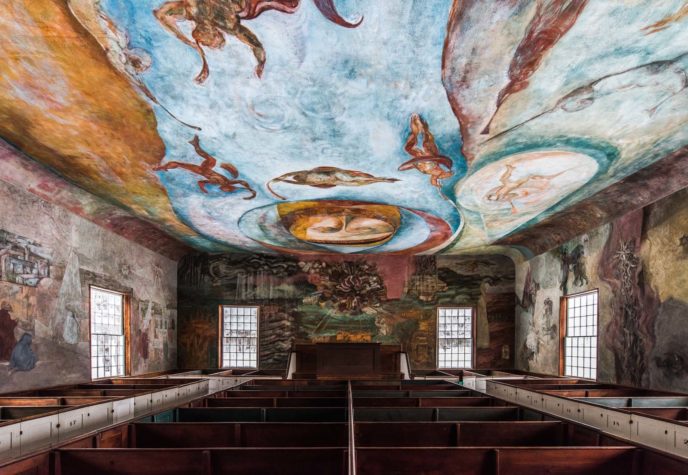
The Secret of South Solon
The South Solon Meeting House hides history on its walls
Upon first approach, the South Solon Meeting House is unassuming. The white clapboard siding and four-pointed bell tower of the 1842 building are reminiscent of other historic meetinghouses that dot Maine’s landscape and mark moments in history. It’s not until its doors open that the building reveals its secret: hand-painted frescoes blanket every wall and span the entire ceiling. Stepping into the South Solon Meeting House feels like walking into a painting, as golds bound by blues and accents of red, green, and yellow cover every inch of plaster inside; each fresco is unique yet complementary to its surrounding artworks. Inside, it’s difficult to feel anything other than a complete sense of amazement.
The idea to paint frescoes in the building came from Margaret Day Blake, who was a student at the Skowhegan School of Painting and Sculpture in the early 1950s. Blake had an interest in preserving the meetinghouse, and after watching a fresco class, she proposed a fellowship program that would allow young professional artists to work in the house under the school’s supervision. Artists submitted sketches to the jury for the Margaret Day Blake Fellowship, and painting began in 1952. Over the next five years, 15 artists labored over the walls and ceiling to create the South Solon Meeting House as it’s known today. Artists included Ashley Bryan, Sidney Hurwitz, and Sigmund Abeles. Fresco, a painting technique in which color is applied to a wet plaster surface, was the perfect method to breathe life into the meetinghouse.
It’s a sanctuary nestled into farmlands—one that continues to welcome all. Mildred H. Cummings, who wrote about the meetinghouse’s extensive history in her 1959 book South Solon: The Story of a Meeting House, sums up what the building has come to be: “The South Solon Meeting House might well have deteriorated, for its original purpose was not compatible with modern times. The fact that it has been preserved is alone important, but the unusual element in its preservation and in its history is the creative position evolved for it in the contemporary world.” Today, the South Solon Historical Society manages the meetinghouse and opens the building to those who wish to visit. Events such as musical concerts, weddings, poetry readings, and the like maintain the building’s purpose as a place for being together.
